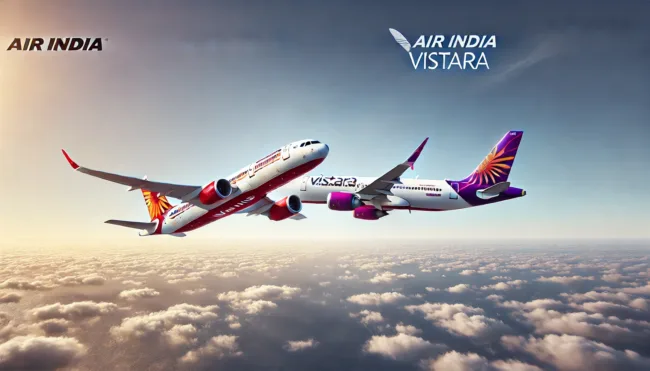Game-changer for Indian skies: Air India to fly Vistara routes after surprise merger approval
Air India will begin operating Vistara flights starting November 12, 2024, following a crucial approval that allows for the full merger of the two airlines. This integration marks the end of Vistara’s nearly decade-long journey, as Tata Group and Singapore Airlines consolidate their aviation holdings under the Air India brand. The merger, viewed as a strategic move to strengthen Air India’s market position, will streamline operations and potentially reshape India’s aviation landscape, making Air India a major player in both domestic and international markets.
The final nod came after Singapore Airlines, which holds a 49% stake in Vistara, received regulatory clearance for its Foreign Direct Investment (FDI) in Air India. This decision effectively removes the last obstacle to the merger, allowing Air India to fully absorb Vistara’s fleet, routes, and workforce. The unified carrier aims to optimise operations, integrating Vistara’s service standards into Air India, known for its extensive network but lagging in terms of service quality in recent years.

Vistara’s pioneering role in Indian skies
Launched in 2015 as a joint venture between Tata Group and Singapore Airlines, Vistara rapidly gained a reputation for offering a premium flying experience, becoming the first airline in India to introduce a Premium Economy class. Vistara also set industry benchmarks by being the first to offer flatbed seats on narrowbody aircraft, targeting both domestic and regional international markets. However, the airline struggled with profitability, registering only a few profitable quarters despite innovative services and a strong market presence.
The integration into Air India brings an end to Vistara’s independent journey, which saw over 500,000 flights and nearly seven crore passengers. According to aviation experts, while Vistara’s brand will cease to exist, its impact on India’s aviation sector, particularly in enhancing customer service and experience, is likely to shape Air India’s future strategy. Air India will benefit from Vistara’s well-established customer base and brand value, which is crucial as it aims to compete against market leader IndiGo and other international carriers.
Strategic implications for the Tata Group
For Tata Group, merging Vistara with Air India represents a significant step in creating a robust, unified airline that can challenge competitors more effectively. The merger is expected to consolidate Tata’s airline operations and create synergies, enabling cost savings and operational efficiencies. Air India’s fleet will now include Vistara’s modern aircraft, such as the Boeing 787-9 Dreamliners and Airbus A321neo, potentially improving service quality and customer experience.
Industry analysts believe that this merger, while complicated due to the integration of different operational systems and work cultures, offers a strategic opportunity to streamline services and focus on profitability. They also note that managing the expectations of Vistara’s loyal customer base will be a critical factor in ensuring a smooth transition.
Navigating the complexities of integration
Integrating two distinct airlines like Vistara and Air India involves multiple challenges, from harmonizing service standards to managing operational and cultural differences. However, if executed well, this merger could redefine Air India’s market position and set new standards in customer experience.
Discover more from Business-News-Today.com
Subscribe to get the latest posts sent to your email.

